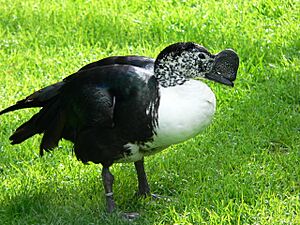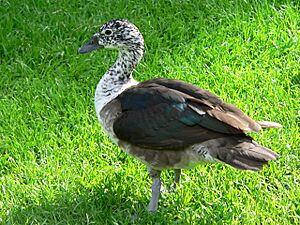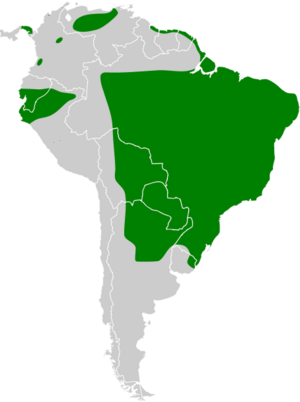Comb duck facts for kids
Quick facts for kids Comb duck |
|
|---|---|
 |
|
| male | |
 |
|
| female | |
| Conservation status | |
| Scientific classification | |
| Genus: |
Sarkidiornis
|
| Species: |
sylvicola
|
 |
|
| Synonyms | |
|
Sarkidiornis melanotos sylvicola |
|
The comb duck or American comb duck (Sarkidiornis sylvicola) is a unique type of duck. You can find it in warm, wet areas called wetlands in South America. These ducks live as far south as the Paraguay River area. This includes parts of eastern Paraguay, southeastern Brazil, and northeastern Argentina. Sometimes, a few comb ducks might even visit Trinidad.
Scientists usually consider the comb duck a separate species from the knob-billed duck. The comb duck is usually a bit smaller. Its sides are also darker. Males have black sides, while females have medium gray sides.
Meet the Comb Duck
The comb duck is easy to spot because it's quite large. It's one of the biggest duck species around! These ducks can be from 56 to 76 centimeters (about 22 to 30 inches) long. Their wings can spread out from 116 to 145 centimeters (about 45 to 57 inches) wide. They usually weigh between 1.03 and 2.9 kilograms (about 2.3 to 6.4 pounds).
Adult comb ducks have a white head with dark spots. Their neck and belly are pure white. Their upper body is a shiny blue-black color. You might see hints of blue and green, especially on their lower arm feathers. Male comb ducks are much bigger than females. They also have a large black knob on their bill.
Young comb ducks might look a bit like a fulvous whistling duck at first glance. However, young comb ducks are almost always with adult comb ducks. This makes them easier to identify.
Where They Live and What They Eat
Comb ducks like to live in quiet freshwater swamps and lakes in warm, tropical places. They usually stay in one area. But they might move around more during the wet season.
These ducks mostly eat plants. They find their food by grazing on grass or dabbling in the water. They also eat small fish, tiny water creatures called invertebrates, and seeds. Sometimes, they can cause problems for farmers who grow rice.
Comb ducks often sit in trees. You'll usually see them in groups. During the wet season, the groups are small. But in the dry season, they can gather in flocks of up to 100 ducks! Sometimes, males and females will form separate groups.
Family Life
Comb ducks like to build their nests in holes in trees. They might also nest in tall grass. They make their nests cozy with reeds, grass, or feathers. However, they don't use soft down feathers.
Male comb ducks can have more than one mate at a time. They might have two mates at once or up to five mates one after another. The males protect the females and their young. But they don't protect the actual nest sites. Males without a mate will often sit in trees. They wait for a chance to find a mate.
Female comb ducks lay between seven and 15 yellowish-white eggs. Sometimes, several females will lay their eggs in one large "dump nest." These nests can hold up to 50 eggs!


